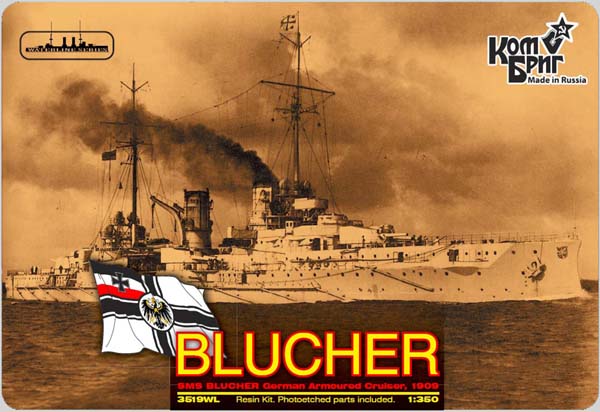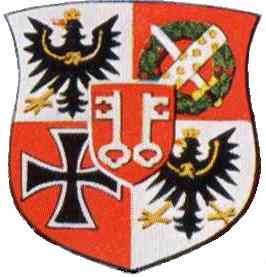1/350 SMS Blücher

In Box Review
Reviewed May 2016
by Martin J Quinn

In Box Review
Reviewed May 2016
by Martin J Quinn
| HISTORY | |||||||||||||||||||
|
The
Blücher was the last armored cruiser built for the Imperial German
Navy. She was almost 60 feet longer, 10 feet wider and had a designed
speed 3 knots faster than the preceding Scharnhorst class of armored cruisers.
She
was laid down in response to the rumored next-generation British armored
cruisers, which were expected to be armed with 9.2 inch guns. Blücher’s
design was too far along to change when the true nature of the Invincible’s
design came to light. While a powerful ship in her own right,
and the next logical step in the evolution of the armored cruiser, she
was hopelessly outclassed by the British creation of a whole new class
of ship.
In
September, 1914, Blücher participated in a failed attempt to lure
the Russian fleet into battle, then, later in the year, she was part of
a pair of bombardments of English coastal towns. She was sunk
in her last, and most famous, engagement, where the picture of her sinking
at Dogger Bank, in January 1915, became one of the most iconic pictures
of the First World War.
For more on Blücher, see the Wikipedia page here: https://en.wikipedia.org/wiki/SMS_Bl%C3%BCcher For more on the Battle of Dogger Bank, see the World War I Naval Combat website, here: http://www.worldwar1.co.uk/dogger-bank.html |
|||||||||||||||||||
| The
Combrig Blücher
Combrig’s 1/350 Blücher comes in the standard white Combrig cardboard box, stating the model represent her as of 1909. On the cover there is a photo of Blücher, prior to her receiving her tripod mast. Inside the box are the upper and lower hull, two boxes with parts, instructions and a photo-etch fret. The hull was wrapped in bubble wrap and the box was packed with Styrofoam peanuts. Upon opening the small boxes, there are four superstructure parts, six turrets, two funnels, a resin wafer with platforms and parts for the masts and cranes cast into it, and over 20 small resin runners with numerous other parts on them – gun barrels, searchlights, boats, etc. |
 |
||||||||||||||||||
|
|
|||||||||||||||||||
| THE HULL | |||||||||||||||||||
|
Both
the upper and lower portions of the hull is cast hollow, which saves lots
of resin (and weight). The dimensions appear to scale out pretty
much perfectly to the real thing. The casting is very well
done. On the upper hull, the engraved plank lines on the deck look
good, though there are no butt ends or margin planking. The
hatches and skylights also have nice detail, while the bollards are crisply
cast.
On
the lower hull, there are a pair of recessed hatches – one on each side
- with a detailed door to represent the underwater torpedo tubes.
The skegs are cast integral to the hull, while the two-piece rudder (one
part is the attachment point on the lower hull) and three screws are cast
separately. Aft of the skegs there is another cut out
in the hull, representing what looks like another torpedo tube.
Each
of the hulls has bracing cast inside of them for structural support.
Both also have a 2mm overpour of resin all the way around them, which will
have to be removed and sanded before you can mate the hull halves together. Blücher's
hull is pretty big - she's as big as the ship that eclipsed her, HMS Invincible.
|
|||||||||||||||||||
|
|
|||||||||||||||||||
| SUPERSTRUCTURE PARTS | |||||||||||||||||||
|
As
mentioned earlier, there are four separate superstructure parts cast separately.
A forward superstructure, an aft superstructure, and two amidships superstructures
that support the funnels.
|
|||||||||||||||||||
|
|
|||||||||||||||||||
| FUNNELS AND TURRETS | |||||||||||||||||||
|
The
funnels are big, and the casting looks okay, except for the raised “foot
rails” that are cast into them. My sample has some of the foot
rails missing or rubbed away. Your copy might not have this
problem, but if it does, you’d probably be best served to sand them all
off for a more uniform look. The more detail oriented among us may
wish to replace them with photo-etch foot rails.
The
turrets are well cast, and all six are identical. On the real ship
there were armored periscopes or sighting hoods on the turret roof, which
were in a different location depending on where the turret sat on the ship.
Those parts have been cast separately.
|
|||||||||||||||||||
|
|
|||||||||||||||||||
| SHIPS BOATS | |||||||||||||||||||
|
There
are nine boats included with the kit. Four are steam powered and
the rest appear to be some sort of cutters of various sizes.
I’m unfortunately not well versed in the terminology of the smaller boats
on warships.
Regardless,
all of them are well cast with good details. The bigger cutters
have planks on the bottoms of the boat, as well as thwarts.
|
|||||||||||||||||||
|
|
|||||||||||||||||||
| ASSORTED PARTS | |||||||||||||||||||
|
The
gun barrels – three different sizes – are all well cast and look good for
resin. The barrels all appear to have small openings cast in the
muzzles. There is nice detail on what I believe are the capstans,
and the cable reels are the best I’ve seen in resin. There are two
runners with many small parts that look like directors – I’m still trying
to figure out what they are and where they go, as I can’t seem to spot
them in the directions. The parts themselves are well done.
There
are several parts on two different runners that appear to be engine room
vents – the largest of these has some of the thinner edges broken off.
This same runner has the spotting top on it. Which means that
this kit represents Blücher post-1914, when the tripod was added,
and is not a 1909 version. One nice feature – the bottom of
the spotting top has locating holes cast in it for the tripod mast legs.
There
is another runner with parts for a pair of guns mounted on the aft superstructure.
The instructions also show you how to make a second, smaller pair of guns
for the same area, with photo-etch shields, but make it seem like you have
option pair of which guns to use. However, there are clearly four
places for guns on the superstructure itself. So you have two different
pairs of guns with vague instructions. As always, consult your references,
though I know of no dedicated volume on Blücher.
The cranes are cast to give the side a recessed appearance, and there is photo-etch to dress these up as well. The anchors are finely rendered, and the searchlights have fine lines on the faces to look like shutters. The resin wafer has a platform that goes on top of the large of the two structures supporting the funnels. Not sure why Combrig didn’t just cast this as one part. The majority of the remaining parts on the wafers are platforms for the searchlights and mast on the forward superstructure. World War I ships, especially early in the war, had sparse superstructures, so there isn’t a lot here. The wafer is a bit thick and the parts may be a chore to sand off. There are no masts, yards or booms included in the kit. There is a section of the instructions which numbers the masts (the numbers correspond with numbers on the instructions) which tell you what size rod to use and how long to cut it. |
|||||||||||||||||||
|
|
|||||||||||||||||||
|
|
|||||||||||||||||||
| PHOTO-ETCH | |||||||||||||||||||
|
There
is a medium sized fret of photo-etch included with the kit. It includes
two sets of torpedo net shelves for each side of the hull (not surprisingly,
no torpedo net is included with the kit), along with boat cradles, inclined
ladders, funnel caps, parts for the cranes, parts for the boats, the aforementioned
gun shields, small shelters for the forward superstructure and the bracing/supports
for the superstructure platforms. There doesn’t appear
to be any relief etching. The photo-etch set is useful but unremarkable.
There are no railings in the kit.
|
|||||||||||||||||||
|
|||||||||||||||||||
| DECALS | |||||||||||||||||||
| There are no decals included with the model. | |||||||||||||||||||
| INSTRUCTIONS | |||||||||||||||||||
|
The
instructions are five pages on three sheets of 8 x 11 paper.
The first page is a plan and profile view of Blücher.
The second page shows photos of all the resin parts. The third page
shows the layout of the photo-etch parts and their numbers, the previously
mentioned dimensions for the masts, and the assembly of the main battery
turrets and secondary guns. The directions show the assembly
of a tripod mast, which again points this model representing Blücher
in her final form.
That
leaves two pages for the rest of the ship, in exploded diagram form.
Not very helpful, but most experienced modelers should have no problems.
|
|||||||||||||||||||
|
|||||||||||||||||||
| CONCLUSIONS | |||||||||||||||||||
|
Blücher
has been forever captured in a moment in time, her sailors teeming over
her sides, as she sinks at the Battle of Dogger Bank. Millions
of people have seen the picture, but only a small fraction of them know
what ship it is, and even less know of her history.
The
next logical step in the armored cruiser (can she be considered the first
heavy cruiser?), Blücher would have been more than a match for the
British Minotaur class, but unluckily for the Germans, out of Jacky Fisher’s
fertile mind sprung the Invincible, thus leaving Blücher as an obsolete
historical footnote.
Combrig’s
big Blücher is a nice size, well-cast and has some good detail.
The only negatives, for me, are the lack of railings and of brass rod for
the masts and torpedo nets. Outside of those minor points, Combrig’s
Blücher should build into an impressive model and make a great addition
to your scale model fleet.
This is Combrig’s 1/350 SMS Blücher, kit number 3519FH. It retails for $256.00, and is available from many of our sponsors. Many thanks to Combrig for the review sample. Recommended, especially for fans of First World War warships. This is an inbox review, your mileage may vary once construction commences. |
 |
||||||||||||||||||
